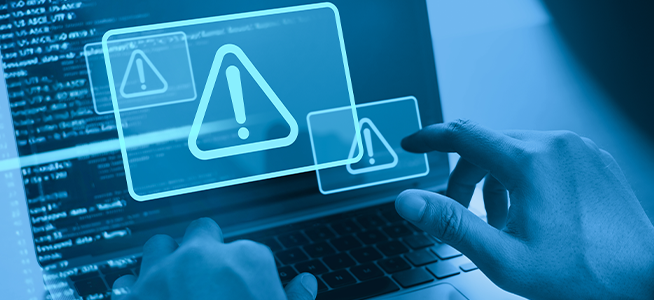What Are the Elements of a Security Risk Assessment?
遵循一致的安全风险评估可确保您的业务为公司数据安全的任何威胁做好准备. With business services that focus on risk assessments, 您的组织将能够识别威胁并创建补救策略. 但是进行信息安全风险评估的方法是什么呢? In this blog, mg官方游戏中心将解释进行风险评估的重要性,并分解安全风险评估实际上是什么.
What Is a Security Risk Assessment?
安全风险评估评估您公司的技术和程序的风险,以确定是否采取措施防止安全威胁. These assessments take a holistic approach to keeping your business safe, and key security controls in applications are identified, evaluated, and implemented. 此外,风险评估强调避免应用程序安全缺陷和漏洞. A security risk assessment examines everything 这可能在很大程度上对公司的安全或合规构成威胁. In addition to finding flaws, 它们还向管理层展示了哪些领域的员工培训是减少攻击面所必需的.
Security risk assessments are in-depth analyses of an entire business, a particular IT project, or business department. 评估的目的是赶在坏人之前识别问题和安全漏洞. 在进行安全风险评估时,安全评估员将审查贵公司系统的所有元素,以发现值得关注的领域. 这些问题可能和允许弱密码的系统一样简单, or they could be more complicated like unsecured business procedures.
The Association of International Certified Professional Accountants (AICPA) mandates security risk assessments as part of a SOC II audit for service businesses, as well as for ISO 27001, HITRUST CSF, and HIPAA compliance.
What Are the 5 Elements of Risk Assessment?
在风险评估期间,评估您的预防性举措如何改变了您的安全状态是至关重要的. For instance, firewalls, vulnerability scanning, penetration testing, access restrictions, 先进的认证程序可以保护高风险基础设施免受网络风险的影响. To determine whether these efforts truly secure your IT assets as intended, you should consistently test and evaluate their effectiveness. To do this, 在你的数据安全风险评估清单中,你应该检查安全风险评估的五个要素:
1. Monitor
即使定期进行风险评估,您也可以采取一些措施来被动地监视网络中的威胁和安全漏洞. Since a security risk assessment offers a comprehensive, detailed, 以及在进行时对漏洞和威胁的准确描述, it is crucial to maintain security while in-between assessments. With tools like anti-virus and malware protection, you can consistently monitor any activity that might be concerning. You can also proactively identify malware, Denial of Service assaults, botnets, 和中间人攻击,并在他们造成任何伤害之前阻止他们正确设置防火墙和威胁情报系统.
2. Identify
To make sure that all of your risks have been adequately mitigated, a security risk assessment identifies all of your essential assets, weaknesses, and controls in your organization. 你们公司的重要技术资产和这些设备产生的敏感数据, store, or transfer may be found through an assessment. 掌握这些知识对于创建适合您业务的风险管理程序至关重要.
3. Create Risk Profile
风险概况是对与特定资产相关的可能危害的分析,可帮助您确定对整体风险环境的危险. In addition to lowering overall security standards costs, 风险概况使得为物理或数字信息资产开发独立的安全程序变得更加简单. 然后,您的组织的安全风险概况可以作为有关网络安全资金和资源分配的决策基础. 这需要理解风险列表将随着威胁环境的变化而改变, the use of technology, or the disclosure of vulnerabilities.
4. Develop Mitigation Plan
如果您不使用信息安全风险评估中的数据来创建缓解策略, none of the information you acquired will safeguard your stakeholders. 风险评估报告用于通过使用IT基础设施分割等缓解方法来控制负面事件的影响, backup policies, disaster recovery, and business continuity plans.
5. Protect Assets
企业安全计划和涉及资产保护的基本原则是了解与安全有关的风险的性质和范围. 鉴于每天都有越来越多的安全风险被识别出来,您的企业将不可避免地在某个时候经历网络攻击或数据泄露. Nearly 15 million data records were exposed in 2022, according to Statista. When an unforeseen catastrophe happens, like a natural disaster or a cyberattack, 对资产进行优先排序可以帮助你确定哪些是最应该保留的. It will also help guide you to rescue and restore first, facilitating the recovery of your business activities.
What Are the 8 Steps of Security Risk Assessment?
To implement the elements of monitoring, identifying, creating a risk profile, developing a mitigation plan, and protecting assets, you can take the following steps:
Produce a comprehensive map of potentially vulnerable assets, including every program, user, and data storage container since they all add to your total attack surface.
Identify security threats and vulnerabilities by simulating actual cyberattacks on your systems, 根据已建立的标准评估您现有的安全准备级别, and learning from the results.
Determine and prioritize risks 通过为每个漏洞分配风险评分,您可以创建补救策略,并将每个威胁或漏洞的成本和收益与您的整个补救预算进行比较.
Analyze and develop security controls 并确定他们是否能够识别风险和弱点,防止它们,或者消除它们.
Document results from a risk assessment report 总结来自不同威胁和脆弱性评估的发现,以明确的排名显示补救策略的重要性顺序.
Create a remediation plan 降低风险,包括每个解决方案的关键、高级程序. It’s also important to consider the related expenses, such as the cost, length of time needed to develop a solution, and disruption to business operations.
Implement recommendations 通过为补救计划中的每个项目分配适当的团队,并在实际的完成时间框架内完成. 还应该有一个行动大纲,说明团队应该采取哪些行动来跟踪其补救活动的成功.
Evaluate effectiveness and repeat 该过程通过持续的监控和优化,如内部审计, risk evaluations, and gap analyses.
Identify Threats and Boost Security with Moser
Our committed IT experts at Moser 要知道始终如一地维护对安全风险的监视和评估是多么具有挑战性. For 25 years, Moser专注于mg官方游戏中心客户的成功,mg官方游戏中心知识渊博的IT团队成员希望帮助您实现业务目标,同时牢记您的安全. Visit our website for more information on our business services.



